

| Name | Description | Object ID | |
|---|---|---|---|
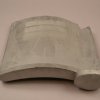 |
Kawara Roof Tile |
This kawara (roof tile) is one of the roof tiles were used for the reconstruction of the Japanese house. It is made of clay, formed in a curved rectangular shape appropriate for the eaves, with a decorative disc on one side. It is silver gray in color. This type of tile is for the... |
AB 80-34 |
 |
Kawara Roof Tile |
This kawara (roof tile) is one of the roof tiles were used for the reconstruction of the Japanese house. It is made of clay, formed in a curved dome shape embellished to resemble a face, and it is silver gray in color. The face has large eyebrows, circular blank eyes, bulging cheeks,... |
AB 80-37 |
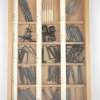 |
Nails |
This assortment of 15 different types of nails is set in a wooden display case. Labels identifying each type of nail run along the top of each compartment, and are written in both Japanese script and in rōmaji (the Latin alphabet). These nails were given to the Museum after the... |
AB 81-138 |
 |
Branding Iron |
This branding iron has the Japanese characters for "Kyo no Machiya" (Kyoto House) and a light wooden handle with a gold rim. The handle is connected to a long metal rod with the symbol welded onto the tip of the rod. |
AB 81-141 |
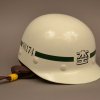 |
Hard Hat |
This plastic, vinyl hard hat was used by construction workers for the dismantling of The Japanese House in 1978 in Kyoto. The white hat has a brown cotton tie for securing at the chin. It is decorated with a green band and the kanji character "moku" ("woodworker") above the... |
AB 81-4 |
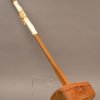 |
Carpenter's Mallet |
This wooden mallet has paper wrapped around the handle and a string of hemp tied on top of the paper. This mallet was used in the beginning of the reconstruction of The Japanese House for heavy work (joining main beams, structure posts, and the like). It was not used in finishing work, except... |
AB 81-40 |
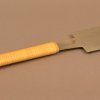 |
Saw |
This carpenter's saw, one of a set of five, is called a ryōba nokogiri in Japanese. Some of the saws in the set were used as back-up tools in the construction of The Japanese House in 1979. The saw has a flat, rectangular blade with small teeth on both sides and a wooden... |
AB 81-46 d |
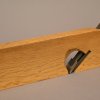 |
Carpenter's Plane |
This carpenter's wood and steel plane was used in the assembly of The Japanese House in 1979. |
AB 81-48 |
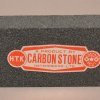 |
Sharpening Stone |
This sharpening stone, or toishi, is made of dark gray, hard, rectangular carbon stone with metallic flecks. The label attached to the side of the stone reads: "A product by Carbon Stone, Hatahoshico, Ltd." The stone is possibly intended for use to sharpen other stones or to flatten.... |
AB 81-49 |
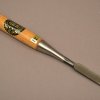 |
Chisel |
This steel chisel with a wooden handle was one of a set of chisels either used in the construction of The Japanese House or as a presentation set in 1979. It has a sticker label with the manufacturer's information, a steel ring at the top of the handle, and another sticker label indicating its... |
AB 81-51 d |
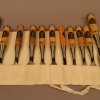 |
Tool Belt |
This white cotton canvas pouch is for storing a set of chisels. It has white cotton ties, reinforced with a leather tab. The pouch is part of a set of chisels either used in the assembly of The Japanese House or as a presentation set in 1979. |
AB 81-51 j |
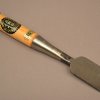 |
Chisel |
This steel chisel, one of a set, was either used in the assembly of The Japanese House or as a presentation set in 1979. It has a wooden handle, a paper label, and a steel ring at the top of the handle. |
AB 81-51 l |
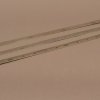 |
Carpenter's Square |
This steel framing square, one of a set of three, is L-shaped and flexible, with markings in green. It is used for conversion from shaku (a traditional Japanese unit of measurement) to the metric system. The framing square was used by carpenters during the construction of The Japanese... |
AB 81-59 a |
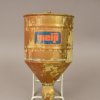 |
Paint Spray Gun |
This brass spraygun is cylindrical in shape with a cone on top and a nozzle attached. A handle is attached to the side. The spraygun was invented by Dr. Koichi Yamada and produced by Kenji Nishikawa of Shikoku Kasei Co. Ltd. as a solution to how to achieve a "Kyoto style" wall effect in The... |
AB 81-60 |
 |
Hammer |
This wood and steel, hand-forged carpenter's hammer is one of a set of three that provide a representative sample of Japanese hammers. It was used in the construction of The Japanese House in 1979. The hammer has one flat face and one pointed end as well as a wooden handle with a manufacturer's... |
AB 81-62 c |
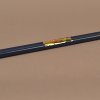 |
Crowbar |
This crowbar is made of steel and painted blue, and was used in the construction of The Japanese House in 1979. It has a "paw" at one end that is painted red, and a square blade at other end. The number 600 is stamped on the upper part, and there is a gold label with Japanese text identifying... |
AB 81-65 |
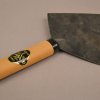 |
Trowel |
This steel trowel with a wooden handle was used in the construction of The Japanese House in 1979. The handle is made of unfinished wood and has a black and gold sticker on it. The trowel has a short, straight, squarish shaft leading to the flat head; it was used for clay, cement, and plaster... |
AB 81-66 d |
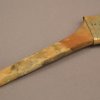 |
Brush |
This brush is one of a set of five wooden natural bristle brushes of varying sizes that was used by carpenters working on The Japanese House project in 1979. The widths of the brushes increase in size from (a) to (e), though (a) and (b) are the same. Each brush has an angled head, and the... |
AB 81-69 d |
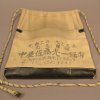 |
Nail Pouch |
This nail bag is made of white canvas and features black lettering. It has a drawstring to secure the bag around the waist, as well as a large, deep pocket and a smaller front pocket containing assorted nails. The text on the front is an advertisement for a nail shop with its phone number. The... |
AB 81-74 |
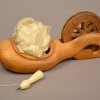 |
Ink Line |
This line marker, called a sumi-tsubo in Japanese, is made of a wooden wheel that holds a line of twisted linen. This linen is fed off the wheel into the well (the hollowed-out section of the body), which is filled with ink-soaked cotton. The linen, now covered with ink, is then drawn... |
AB 84-13 |